Photocoagulation – the deliberate destruction of tissue by absorption of radiant energy and its conversion to heat – is a treatment undertaken to save another area of tissue deemed more valuable. It has become a primary tool in the treatment of myriad ocular conditions.
Socrates first described nonlaser photocoagulation in 400 B.C. after observing solar eclipse burns of the retina. But it was not until an afternoon in July 1945 when an unfortunate medical student viewed a partial eclipse of the sun in Northern Europe that the potential benefits of light burns to the eye were first realized.
The student in question worked under German ophthalmologist Dr. Gerhard Meyer-Schwickerath, who came to the conclusion in 1947 that an evolving retinal detachment stops at a scar. The idea to produce artificial scars by intense light illumination came to him in the same year during a restless night where he wrote two words, “light” and “coagulation,” on a sheet of paper, so as not to forget the thought by morning.
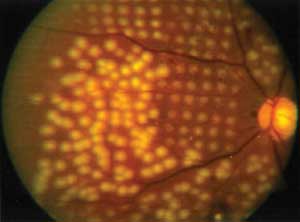
A fundus photograph showing treatment with single-spot conventional photocoagulation burns (bottom left) and adjacent areas treated with patterned scanning laser photocoagulation (top right). Courtesy of Dr. Yannis M. Paulus.
In 1957, the light coagulator was presented by Carl Zeiss as the first commercially available photocoagulation device, and more than 1000 were sold until the late 1970s.
But it was the invention of the laser in 1960 that catapulted this technology into ophthalmology. Since that time, photocoagulation lasers have been reduced continuously in volume, weight and price.

Types of photocoagulation lasers (CW = continuous wave). Courtesy of Dr. Yannis M. Paulus, Byers Eye Institute at Stanford, Stanford University.
Although photocoagulation is used in almost every surgical specialty – e.g., lasers to treat vascular lesions, benign and malignant tumors, and bleeding ulcers – Dr. Matthias Schulze, director of marketing at Coherent Inc., believes that the use of photocoagulation in ophthalmology is the most important because of the growing market: More and more older people are suffering from vision deterioration such as that resulting from age-related macular degeneration (AMD), the leading cause of blindness in the Western world.
Laser photocoagulation can be used to treat the wet form of AMD, in which blood vessels start to leak into the retina, creating fogging and, later, a blind spot in the center viewpoint. Other ocular conditions that can be treated include proliferative diabetic retinopathy, diabetic macular edema, vascular occlusions, central serous chorioretinopathy, retinal tears, tumors, choroidal neovascularization, arterial macroaneurysms and retinopathy of prematurity.
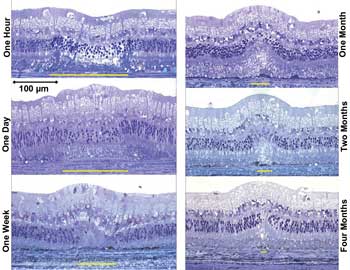
Histology of light retinal photocoagulation lesions produced with 7-ms-pulse-duration burns reveals healing of photocoagulation lens over four months, resulting in almost continuous normal retinal morphology. Reprinted with permission from the Association for Research in Vision and Ophthalmology, from Y.M. Paulus et al (2008). Healing of retinal photocoagulation lesions. Invest Ophthal Vis Sci, Vol. 49, Issue 12, pp. 5540-5545.
“The treatment strategy utilized for photocoagulation varies, depending upon the particular disease process,” said Dr. Adrienne W. Scott, assistant professor of ophthalmology at The Wilmer Eye Institute, Retina Div., at Johns Hopkins Hospital in Baltimore. “Typically, these procedures are performed in the outpatient clinic with the use of topical anesthetic eyedrops.”
A contact lens is positioned onto the eye to lubricate the cornea and hold open the eyelid. The laser settings – including power, spot size, pulse duration and repetition rate – are selected, and the aiming beam is focused through the pupil onto the desired areas for retinal treatment.
Recent studies have demonstrated that the science behind photocoagulation is more complicated than once thought and that heating produces a constellation of changes at the molecular level in individual cells; e.g., photocoagulation creates a surge in free radicals.
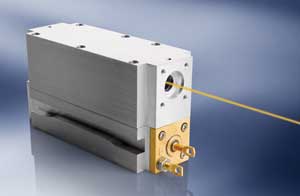
Coherent’s Genesis 577 laser is used in photocoagulation applications. Courtesy of Coherent Inc.
Progress so far
Developments in laser technology have made lasers of various wavelengths possible, and the wavelength selected depends upon the type of procedure being performed.
The wavelengths typically used for retinal photocoagulation range from ~400 to 800 nm. This spans the majority of the visible electromagnetic spectrum (violet, 380 nm, to red, 750 nm) and part of the infrared spectrum (750 nm to 1 mm).
“The ideal wavelength is characterized by good penetration through ocular media and maximal absorption in the target tissue. Shorter wavelengths are more easily scattered; hence, red light (620 to 750 nm) has better penetration than blue light (450 to 495 nm),” Scott said. “Scatter is a result of radiation absorption by tissues other than the target. It can occur anywhere anterior to the retina, including the anterior segment, lens and vitreous.”
The degree of scattering increases with the maturity of the cataract – a clouding of the lens of the eye – and vitreous hemorrhage. In such cases, Scott suggests that a longer wavelength, increased laser duration or higher energy levels may be required.
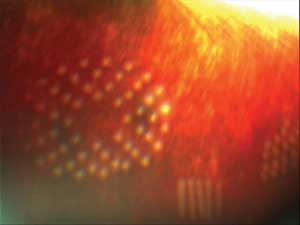
This fundus photograph shows laser burns after application with the OptiMedica Corp.-designed pattern scan laser photocoagulator PASCAL (now produced by Topcon Corp. of Tokyo). The circular and square patterns were made in <1 s with a scanning laser and shorter pulse duration. Courtesy of Dr. Yannis M. Paulus.
Typical laser power levels range from 1.5 to 8 W. The power often is adjusted during a procedure to ensure that the desired burn is applied over the surface of the eye. This approach is known as titration and is necessary because laser power can vary dramatically among individuals. Table 1 summarizes the systems, wavelengths and pulse durations of currently available laser photocoagulators.
“The green laser wavelength is the most commonly used laser for photocoagulation and is mainly employed in two systems: argon gas (514.5 nm) and solid-state frequency-doubled Nd-YAG (532 nm),” Scott said. “Argon green laser confers the advantage of a strong affinity for melanin and hemoglobin with minimal absorption of xanthophyll, the predominant pigment in the macula.”
However, Dr. Yannis M. Paulus at Stanford University’s Byers Eye Institute at Stanford in California explains that the yellow laser (577 nm) is preferable to green in macular and vascular diseases for numerous reasons. “It is less affected by small-angle scattering in the transparent ocular media and provides greater transmittance through corneal opacities,” he said. “Yellow light is an absorption maximum of oxyhemoglobin, allowing for better selective treatment of vasculature and more uniform absorption.”
Until recently, yellow lasers were limited to costly tunable dye and Krypton lasers. However, this changed in 2008 with the advent of optically pumped semiconductor lasers based on near-infrared-pumped quantum-well structures.
For Coherent’s Schulze, the most versatile systems feature green, yellow and red in a combined tool.
Better understanding, better treatment
Ophthalmologists and laser makers alike are striving toward a greater understanding of the mechanism of action in photocoagulation so that minimally traumatic retinal lasers can be designed for safe and effective use in any area of the retina, including the macula.
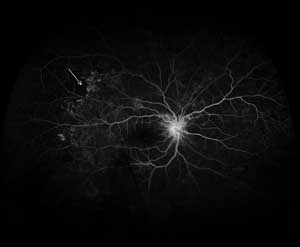
A wide-field fluorescein angiogram of a patient with diabetic retinopathy demonstrates profound peripheral capillary dropout. The white arrow points out areas of the peripheral retina that appear dark on fluorescein angiography because of the absence of the normal retinal capillaries in the setting of diabetic retinal ischemia. Courtesy of Dr. Adrienne W. Scott.
“We have come to understand that the therapeutic effect from photocoagulation is not only from tissue destruction but rather from a complex biological response to photocoagulation,” Paulus said. “If we can induce this therapeutic effect without causing permanent retinal scarring, we could treat the entire retina in a short period of time without worrying about protecting vital structures, and even retreat areas of retina.”
Rather than watching for a visible change in the retina, one aim is for real-time monitoring of retinal temperature during laser coagulation.
For many coagulator manufacturers, one of the open issues in photocoagulation is choosing the right dosage of laser energy during a treatment session.
The retina of an elderly patient suffering from severe diabetic retinopathy is strongly varying in pigmentation, absorption and scattering losses from point to point; therefore, for a proper therapy result, the laser power should be adjusted individually for every laser spot.
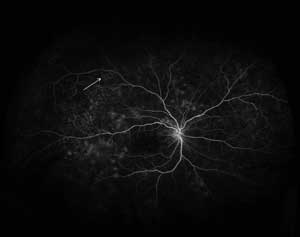
This is the same patient, one week after scatter laser photocoagulation to the peripheral retina using a targeted argon green laser (PASCAL) on the areas of poor retinal circulation. The laser lesions, indicated by the white arrow, are seen as round dark spots within the peripheral retina. Courtesy of Dr. Adrienne W. Scott.
In daily clinical practice, this is impossible when setting up to 2500 lesions within a single photocoagulation session. The titration process typically involves starting with a single spot (or a small pattern) in the midperiphery and increasing the laser power until a proper whitening of the retinal tissue occurs.
After this initial setting, the laser energy is changed if the whitening disappears or is becoming far too strong. This typically occurs five to 10 times a session. The result is areas of over- and undertreatment, which becomes worse in multispot therapy.

The Navilas laser platform showing preplanning of laser spots. Courtesy of OD-OS Retina Navigation Co.
Some medical photonics companies are working on an individual, feedback-controlled laser treatment to optimize outcomes and minimize side effects. Low-dose laser technologies might have a certain effect on one point of the retina but a zero effect if the tissue slightly alternates.
Although not yet clear whether supra-threshold, just-above-threshold or subthreshold laser therapy would provide the maximum benefit for the patient, there is confidence that physicians will figure this out by using automated dosimetry-controlled photocoagulation therapy lasers. Once this clinical work is completed, we should know which treatment option will be best and whether image-guided laser therapy is clinically needed or only a nice-to-have but expensive feature.